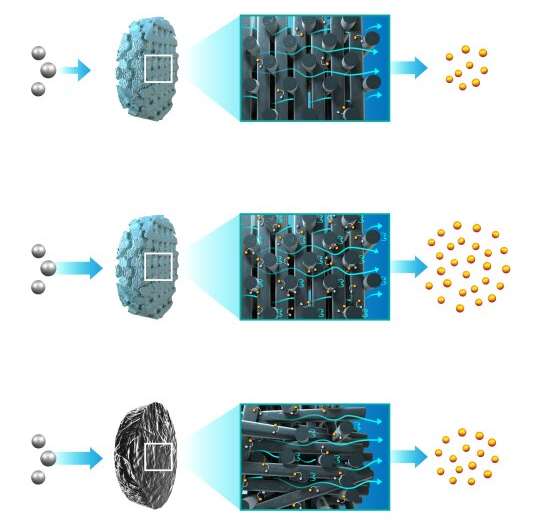Team uses 3D printing to optimize flow-through electrodes for electrochemical reactors

To take advantage of the growing abundance and cheaper costs of renewable energy, Lawrence Livermore National Laboratory (LLNL) scientists and engineers are 3D printing flow-through electrodes (FTEs), core components of electrochemical reactors used for converting CO2 and other molecules to useful products.
As described in a paper published by the Proceedings of the National Academy of Sciences, LLNL engineers for the first time 3D-printed carbon FTEs—porous electrodes responsible for the reactions in the reactors—from graphene aerogels. By capitalizing on the design freedom afforded by 3D printing, researchers demonstrated they could tailor the flow in FTEs, dramatically improving mass transfer—the transport of liquid or gas reactants through the electrodes and onto the reactive surfaces. The work opens the door to establishing 3D printing as a "viable, versatile rapid-prototyping method" for flow-through electrodes and as a promising pathway to maximizing reactor performance, according to researchers.
"At LLNL we are pioneering the use of three-dimensional reactors with precise control over the local reaction environment," said LLNL engineer Victor Beck, the paper's lead author. "Novel, high-performance electrodes will be essential components of next-generation electrochemical reactor architectures. This advancement demonstrates how we can leverage the control that 3D printing capabilities offer over the electrode structure to engineer the local fluid flow and induce complex, inertial flow patterns that improve reactor performance."
Through 3D printing, researchers demonstrated that by controlling the electrodes' flow channel geometry, they could optimize electrochemical reactions while minimizing the tradeoffs seen in FTEs made through traditional means. Typical materials used in FTEs are "disordered" media, such as carbon fiber-based foams or felts, limiting opportunities for engineering their microstructure. While cheap to produce, the randomly ordered materials suffer from uneven flow and mass transport distribution, researchers explained.
"By 3D printing advanced materials such as carbon aerogels, it is possible to engineer macro-porous networks in these material without compromising the physical properties such as electrical conductivity and surface area," said co-author Swetha Chandrasekaran.
The team reported the FTEs, printed in lattice structures through a direct ink writing method, enhanced mass transfer over previously reported 3D printed efforts by 1-2 orders of magnitude, and achieved performance on par with conventional materials.
Because the commercial viability and widespread adoption of electrochemical reactors is dependent on attaining greater mass transfer, the ability to engineer flow in FTEs will make the technology a much more attractive option for helping solve the global energy crisis, researchers said. Improving the performance and predictability of 3D-printed electrodes also makes them suitable for use in scaled-up reactors for high efficiency electrochemical converters.
"Gaining fine control over electrode geometries will enable advanced electrochemical reactor engineering that wasn't possible with previous generation electrode materials," said co-author Anna Ivanovskaya. "Engineers will be able to design and manufacture structures optimized for specific processes. Potentially, with development of manufacturing technology, 3D-printed electrodes may replace conventional disordered electrodes for both liquid and gas type reactors."
LLNL scientists and engineers are currently exploring use of electrochemical reactors across a range of applications, including converting CO2 to useful fuels and polymers and electrochemical energy storage to enable further deployment of electricity from carbon-free and renewable sources. Researchers said the promising results will allow them to rapidly explore the impact of engineered electrode architectures without expensive industrialized manufacturing techniques.
Work is ongoing at LLNL to produce more robust electrodes and reactor components at higher resolutions through light-based 3D polymer printing techniques such as projection micro-stereolithography and two-photon lithography, flowed by metallization. The team also will leverage high performance computing to design better performing structures and continue deploying the 3D-printed electrodes in larger and more complex reactors and full electrochemical cells.
More information: Inertially enhanced mass transport using 3D-printed porous flow-through electrodes with periodic lattice structures, Proceedings of the National Academy of Sciences (2021).
Journal information: Proceedings of the National Academy of Sciences
Provided by Lawrence Livermore National Laboratory




















